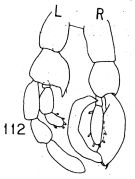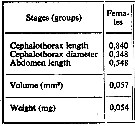|
|
 |
|
Calanoida ( Order ) |
|
|
|
Lucicutiidae ( Family ) |
|
|
|
Lucicutia ( Genus ) |
|
|
| |
Lucicutia gemina Farran, 1926 (F,M) | |
| | | | | | | Ref.: | | | Farran, 1926 (p.275, Descr.F,M, figs.F); 1929 (p.209, 263); Rose, 1933 a (p.196, figs.F,M); Farran, 1936 a (p.111, Rem.); Sewell, 1948 (p.384, 465, 503, 547, 550); Djordjevic, 1963 (p.576); Vervoort, 1965 (p.113, Rem.); Hülsemann, 1966 (p.715, figs.F,M); Razouls, 1972 (p.95, Annexe: p.74); Björnberg & al., 1981 (p.648, figs.F,M); Bradford-Grieve & al., 1999 (p.883, 945, figs.F,M); Bradford-Grieve,1999 b (p.100, figs.F,M, Rem., figs.176, 191); Boxshall & Halsey, 2004 (p.133: F; p.134: M); Avancini & al., 2006 (p.99, Pl. 68, figs.F,M, Rem.); Vives & Shmeleva, 2007 (p.334, figs.F,M, Rem.) |  issued from : J.M. Bradford-Grieve in The Marine Fauna of New Zealand: Pelagic Calanoid Copepoda. National Institute of Water and Atmospheric Research (NIWA). NIWA Biodiversity Memoir, 111, 1999. [p.101, Fig.65]. Female (from 34°32.5' S, 157°31.5' E): A, habitus (dorsal). Nota: A1, when held straight posteriorly, extends to posterior border of caudal rami on some females Male (from 25°46, 170°16 E): habitus (dorsal).
|
 issued from : J.M. Bradford-Grieve in The Marine Fauna of New Zealand: Pelagic Calanoid Copepoda. National Institute of Water and Atmospheric Research (NIWA). NIWA Biodiversity Memoir, 111, 1999. [p.101, Fig.65]. B, genital somite (left lateral side); C, P5. Male: E, P1; F, P5 (L = left leg; R = right leg).
|
 Issued from : K. Hülsemann in Bull. Mar. Sc., 1966, 16 (4). [p.720, Figs.79, 82]. Female: 79, P5; 82, urosome (dorsal).
|
 Issued from : K. Hülsemann in Bull. Mar. Sc., 1966, 16 (4). [p.726, Fig.112]. Male: 112, P5.
|
 issued from : G.P. Farran in Biscayan Plankton collected during a Cruise of H.M.S. 'Research', 1900.- Part XIV. The Copepoda. (Linn. Journ. Zoology, XXXVI, 1926). [p.304, Pl.9, Figs.4-8]. Female: 4, habitus (lateral); 5, last urosomal segments and caudal rami (dorsal); 6, 2nd basipod of P1; 7, P2; 8, P5.
|
 Lucicutia gemina Lucicutia gemina female: 1 - Characters following not combined : Prosome about 3 times longer than urosome. Cephalosome with slightly projecting and rounded anterior corners and well developed lateral spinous projections; anal somite about as long as wide; caudal rami 11.7 times longer than wide and bowed outwards at base, leaving elliptical space between rami proximally. 2 - P1 with 3-segmented endopod. 3 - Cephalosome without lateral spinous projections. 4 - Genital double-somite symmetrical (dorsal view). 5 - Anal somite much shorter than caudal ramus. 6 - P5 with 3-segmented endopod. 7 - Characters not combined between distal 3 to 4 segments of A1 reaching beyond tip of caudal ramus and body length less than 3mm. 8 - Cephalosome without projections. 9 - Terminal setal element of P5 about half length of 3rd exopodal segment; body length less than 2 mm. 10 - Caudal rami parallel and touching; anal somite as long as preceding somite; genital swelling small.
|
 Lucicutia gemina Lucicutia gemina male: 1 - P1 with 3-segmented endopod. 2 - Cephalosome without lateral projections. 3 - Right A1 reaching at most 2 segments beyond tip of caudal rami. 4 - Caudal rami at most 7 times longer than wide. 5 - Inner margin of basis of both P5 without pointed process; endopod of right P5 -2 segmented. . 6 - Caudal rami more than 4 times longer than wide. 7 - Body length less than 2.0 mm. 8 - A1 reaching only to midlength of caudal rami; anal somite as long as preceding somite; basis of left P5 with produced inner distal corner terminating in single point.
| | | | | Compl. Ref.: | | | C.B. Wilson, 1950 (p.255); V.N. Djordjevic, 1963 (p.576); Greze, 1963 a (tabl.2); Shmeleva, 1963 (p.141); Unterüberbacher, 1964 (p.29); Grice & Hulsemann, 1965 (p.224); Shmeleva, 1965 b (p.1350, lengths-volume -weight relation); Mazza, 1966 (p.71); Pavlova, 1966 (p.44); Delalo, 1968 (p.138); Park, 1970 (p.477); Bainbridge, 1972 (p.61, Appendix Table I: vertical distribution vs day/night); Bradford, 1972 (p.46: Rem.); Binet & al., 1972 (p.53, 69); Björnberg, 1973 (p.343, 387); Deevey & Brooks, 1977 (p.256, tab.2, Station "S"); Dessier, 1979 (p.206); Kovalev & Shmeleva, 1982 (p.84); Scotto di Carlo & al., 1984 (1041); Cummings, 1984 (p.163, Table 2); Roe, 1984 (p.358); Greze & al., 1985 (p.7); Brenning, 1985 a (p.28, Table 2); Brinton & al., 1986 (p.228, Table 1); Wishner & Allison, 1986 (tab.2); Brenning, 1986 (p.13, Rem.); Scotto di Carlo & al., 1991 (p.270); Ashjian & Wishner, 1993 (p.483, abundance, species group distributions); Shih & Young, 1995 (p.70); Hure & Krsinic, 1998 (p.66, 102); Suarez-Morales & Gasca, 1998 a (p.110); Lapernat, 1999 (p.22, 55); Siokou-Frangou, 1999 (p.476); Lapernat, 2000 (tabl.3, 4); Lapernat & Razouls, 2001 (p.123, tab.1); Fernandez-Alamo & al., 2000 (p.1139, Appendix); Vukanic, 2003 (139, tab.1); Hsiao & al., 2004 (p.326, tab.1); Lo & al., 2004 (p.89, tab.1); Vukanic & Vukanic, 2004 (p.9, tab. 2, 3); Zervoudaki & al., 2006 (p.149, Table I); Koppelmann & Weikert, 2007 (p.266: tab.3); Dur & al., 2007 (p.197, Table IV); Neumann-Leitao & al., 2008 (p.799: Tab.II, fig.6); Morales-Ramirez & Suarez-Morales, 2008 (p.520); Raybaud & al., 2008 (p.1765, Table A1); Williamson & McGowan, 2010 (p.273, Table 3, Pacific central gyres: N and S); Schnack-Schiel & al., 2010 (p.2064, Table 2: E Atlantic subtropical/tropical); Mazzocchi & Di Capua, 2010 (p.426); Medellin-Mora & Navas S., 2010 (p.265, Tab. 2); Hsiao S.H. & al., 2011 (p.475, Appendix I); Selifonova, 2011 a (p.77, Table 1, alien species in Black Sea); Shiganova & al., 2012 (p.61, Table 4); Uysal & Shmeleva, 2012 (p.909, Table I); Belmonte & al., 2013 (p.222, Table 2, abundance vs stations); Lidvanov & al., 2013 (p.290, Table 2, % composition); Siokou & al., 2013 (p.1313, fig.4, 8, biomass, vertical distribution); Mazzocchi & al., 2014 (p.64, Table 4, 5, abundance); Benedetti & al., 2016 (p.159, Table I, fig.1, functional characters); El Arraj & al., 2017 (p.272, table 2); Benedetti & al., 2018 (p.1, Fig.2: ecological functional group); Belmonte, 2018 (p.273, Table I: Italian zones) | | | | NZ: | 17 | | |
|
Distribution map of Lucicutia gemina by geographical zones
|
| | | | | | | | | | | |  issued from : A.A. Shmeleva in Bull. Inst. Oceanogr., Monaco, 1965, 65 (n°1351). [Table 6: 31 ]. Lucicutia gemina (from South Adriatic). issued from : A.A. Shmeleva in Bull. Inst. Oceanogr., Monaco, 1965, 65 (n°1351). [Table 6: 31 ]. Lucicutia gemina (from South Adriatic).
Dimensions, volume and Weight wet. Means for 50-60 specimens. Volume and weight calculated by geometrical method. Assumed that the specific gravity of the Copepod body is equal to 1, then the volume will correspond to the weight. |
| | | | Loc: | | | Namibia, Congo, G. of Guinea, Ivorian shelf, Cape Verde Is. ( S & NW), Senegal-Mauritania, Morocco-Mauritania, Brazil S, off Amazon, Caribbean Sea, Caribbean Colombia, G. of Mexico, off Bermuda (Station "S"), Sargasso Sea, off Cape Hatteras, Gulf Stream, W Ireland, Bay of Biscay, off W Cape Finisterre, Ibero-moroccan Bay, Medit. (Alboran Sea, NW Basin, Banyuls, Ligurian Sea, Tyrrhenian Sea, Strait of Messina, Gulf of Taranto, off Malta, Adriatic Sea, Ionian Sea, Aegean Sea, Levbanon Basin, Black Sea), Red Sea, Indian, Philippines, China Seas (East China Sea, South China Sea), Taiwan (SW, E, N: Mienhua Canyon), Australia (Great Barrier), Tasman Sea, New Zealand (N North Island, off NE & NW), Pacific (central gyres: N and S), California, Gulf of California, G. de Tehuantepec, W Costa Rica, N Chile | | | | N: | 68 | | | | Lg.: | | | (16) F: 1,85; (21) F: 1,9-1,4; M: 1,7-1,3; (34) F: 1,6-1,42; (35) F: 1,78-1,6; (38) F: 1,86-1,75; M: 1,72-1,63; (340) F: 1,5; (432) F: 1,71-1,62; (909) F: 1,35-1,7; M: 1,25-1,7; (1108) F: 1,68; {F: 1,35-1,90; M: 1,25-1,72}
| | | | Rem.: | epi-mesopelagic, sampling depth (off Malta): 3000 m. Overall Depth Range in Sargasso Sea: 0-1000 m (Deevey & Brooks, 1977, Station "S");
According to Vervoort (1965, p.113) this species is very closely allied to L. flavicornis, so much so, that it has probably been frequently cofused with the latter.
For Hülsemann (1966, p.717), Giesbrecht (1892) drew attention to the two forms ( L. gemina and L. flavicornis) and considered them to be variations of L. flavicornis. Tanaka (1963) also found L. gemina but retained the specimens in the species L. flavicornis, because the internal spine on the 2nd exopodal segment of P5 in the female was relatively longer than in Farran's (1926) desciption.
After Lapernat & Razouls (2002, p.19) the Itoh's index value = 587.6 (number of teeth: 9) on the right Md, and 632.1 on the left Md (number of teeth: 8).
After Benedetti & al. (2018, p.1, Fig.2) this species belonging to the functional group 4 corresponding to small filter feeding herbivorous and mixed feeding omnivorous (mostly broadcasters). | | | Last update : 24/10/2022 | |
|
|
 Any use of this site for a publication will be mentioned with the following reference : Any use of this site for a publication will be mentioned with the following reference :
Razouls C., Desreumaux N., Kouwenberg J. and de Bovée F., 2005-2024. - Biodiversity of Marine Planktonic Copepods (morphology, geographical distribution and biological data). Sorbonne University, CNRS. Available at http://copepodes.obs-banyuls.fr/en [Accessed April 19, 2024] © copyright 2005-2024 Sorbonne University, CNRS
|
|
 |
 |









